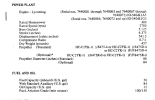Pinecone
En-Route
Then there is that your spark plugs will last longer.I change my own oil. Cost of oil and filter is half of what you mentioned. That's not enough (cost-wise) to make me switch. And as OCT mentioned above, if the extra $1 is their production cost, not price at the pump, then the math becomes even more unfavorable for them.
At that point, we ethanol-proof our fuel systems, figure out a safe additive to handle water in fuel (I hear some people mention isopropyl alcohol?) and we convince airport managers to fill their tanks with mogas instead.
And it is likely the engine will last longer. And even more so if we can get some synthetic oils.
In dino oil days, auto engines were good for about 100,000 miles. Now they do 250K or more. How about skipping even just one overhaul?
Funny thing about fuel prices, when I was flying before my hiatus, everyone was squawking about the demise of GA if AVGAS prices went over $4 per gallon. And you could still find fuel for under $2 per gallon. Now the sky is falling if we hit $10. Will some people stop flying? Sure. But even if fuel prices don't go up, a number of people will stop flying.

